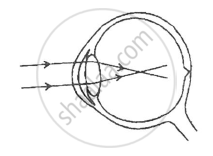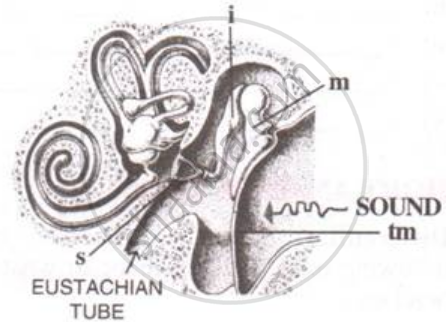Advertisements
Advertisements
प्रश्न
Given below is a diagram depicting a defect of the human eye, study the same and then answer the questions that follow:

(i) Name the defect shown in the diagram.
(ii) What are the two possible that cause this defect?
(iii) Name the type of lens used to correct this defect.
(iv) With the help of a diagram show how the defect shown above is rectified using a suitable lens.
उत्तर
(i) Myopia
(ii) Two possible reasons are
- Eye ball is lengthened from front to back.
- Lens is too curved.
(iii) Concave lens
(iv)
APPEARS IN
संबंधित प्रश्न
Explain how the human ear works.
Draw labelled diagrams of the following: Ear
Photoreceptor cells are present in __________.
(A) blind spot
(B) retina
(C) cochlea
(D) cornea
A fluid that occupies the larger cavity of the eye ball behind the lens is
___________.
The ear ossicle which is attached to the tympanum.
Sclerotic layer or choroid layer.(Which one forms the Iris ?)
Mention if the following statement is true (T) or false (F) Give reason.
Malleus incus and stapes are collectively called the ear ossicles.
Where is the Utriculus located? Briefly mention its function.
With reference to the human ear, answer the question that follow:
Name the three small bones present in the middle ear. What is the biological term for them collectively ?
What is the biological term for the three small bones present in the middle ear collectively?
The figure below is the sectional view of a part of the skull showing s sense organ:

Name the sense organ.
Name the nerve which carries electrical impulses from the cochlea of ear to the brain.
Given below is a diagram of a part of the human ear. Study the same and answer the question that follow:

State the functions of the parts labeled 'A' and 'B'.
State the functions of the following:
Semi-circular canals
Select the CORRECT match of part of the human ear and its function.
The part of the ear that turns pressure variations into electrical signals is ______.
The Eardrum moves inward when a rarefaction reaches it.
The median canal of cochlea is filled with ______.
With reference to human ear answer the question that follow:
Name the part of the ear associated with Static balance.
With reference to human ear answer the question that follow:
Name the part of the ear associated with the amplification of vibrations.
